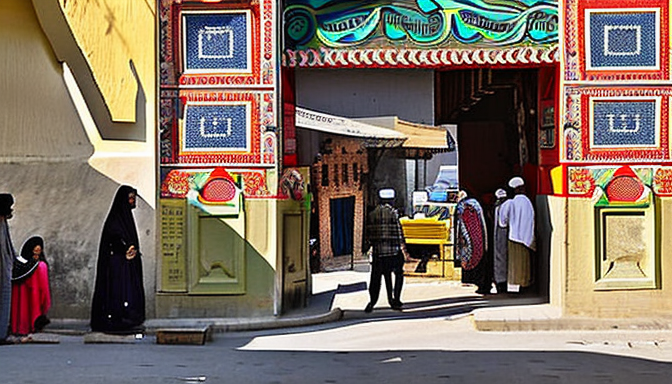Karachi, a bustling metropolis, is not just a modern city; it’s a canvas painted with stories from the past. The colonial era left a mark on its architecture that still stands tall today. Have you ever walked past a grand building and wondered about its history? Each structure whispers tales of the British influence that shaped the city. From the soaring arches of the Frere Hall to the intricate designs of the Mohatta Palace, these landmarks are more than just buildings; they are testaments to a time when Karachi was a key player in the British Empire.
The architectural styles brought by the British are a blend of Gothic, Islamic, and Indo-Saracenic elements. This fusion created a unique skyline that reflects the city’s diverse history. Think of it as a melting pot of cultures, where each style tells a story. For instance, the iconic Empress Market, originally built to serve the British elite, now bustles with the vibrancy of local life. It’s a perfect example of how colonial policies influenced urban development, often prioritizing certain communities over others.
As we explore these landmarks, we uncover not just bricks and mortar, but the narratives of the people who lived and worked around them. Historical events, like the partition and subsequent migrations, have shaped these structures, making them a vital part of Karachi’s evolving identity. Have you ever thought about how these buildings have survived the test of time? Their endurance reflects the resilience of the city itself, a place where history and modernity coexist.
The Architectural Influence of Colonial Powers
Karachi’s skyline tells a story, a story shaped by the hands of colonial powers. When the British arrived, they didn’t just bring their rule; they brought their architecture too. Think about it: how many times have you walked past a building and felt its history? The Victorian and Gothic styles are not just decorative; they are reminders of a time when Karachi was a bustling port city under British control.
These colonial influences are evident in many iconic structures. Take the Frere Hall, for example. Built in 1865, it showcases the intricate brickwork and arched windows typical of British architecture. It’s not just a pretty face; it’s a piece of history, a gathering place that has witnessed countless events over the years. And let’s not forget the Empress Market, a vibrant hub that reflects the bustling trade of the colonial era. Its design is a beautiful blend of Islamic and Victorian styles, making it a unique landmark.
The British also had policies that influenced urban planning. They aimed to create a city that reflected their ideals—wide roads, parks, and public buildings. This vision shaped Karachi into a city of contrasts, where modernity met tradition. Today, these colonial structures stand tall, not just as remnants of the past but as active participants in the city’s narrative. They remind us of the complexities of Karachi’s identity and its journey through time.
Karachi’s colonial landmarks tell a story that goes beyond bricks and mortar. They are witnesses to a time when the British Empire made its mark on this vibrant city. Imagine walking through streets lined with buildings that have seen the rise and fall of empires. Each structure whispers tales of political shifts, cultural exchanges, and social upheavals. One pivotal event was the British Raj, which began in the 19th century. During this period, the British implemented policies that not only transformed Karachi’s skyline but also its identity. They introduced Western architectural styles that merged with local designs, creating a unique blend. Think of the stunning Frere Hall or the grand Karachi Port Trust Building. These aren’t just buildings; they are symbols of a time when Karachi was a bustling hub for trade and culture. Another significant moment was the Partition of 1947. This event reshaped the city and its landmarks. Many colonial structures were abandoned, while others became sites of memory for those who lost their homes. The impact of this upheaval is still felt today, as communities continue to navigate their identities amidst these historic backdrops. Ultimately, Karachi’s colonial architecture is more than just a visual feast. It is a tapestry woven from the threads of history, culture, and resilience. Each landmark stands as a testament to the city’s ability to adapt and evolve, inviting us to explore the stories that shaped its past. So, the next time you stroll through Karachi, take a moment to appreciate these remarkable structures. They hold the secrets of a city that has always been in motion. Karachi boasts several remarkable colonial landmarks, including the iconic Frere Hall, the stunning Mohatta Palace, and the impressive Sindh High Court. Each of these structures tells a unique story about the city’s past and architectural evolution. Colonial powers, particularly the British, introduced various architectural styles such as Gothic, Indo-Saracenic, and Art Deco. This blend of influences not only shaped the skyline but also reflected the cultural dynamics of the time, making Karachi a fascinating case study in architectural history. Preserving colonial landmarks is crucial as they serve as tangible links to our history. They offer insights into Karachi’s cultural heritage and identity, reminding us of the diverse narratives that have shaped the city over the years. Yes! There are several guided tours available that focus on Karachi’s colonial architecture. These tours provide a deeper understanding of the historical significance and stories behind each landmark, making for an enriching experience.
Frequently Asked Questions